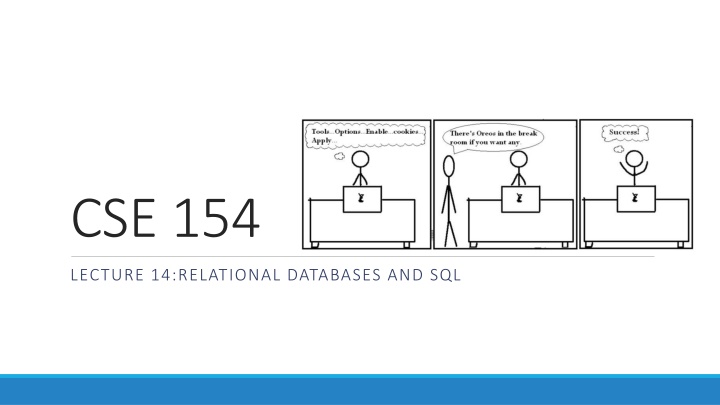
Understanding Relational Databases and SQL Concepts
Relational databases organize data into tables linked by shared attributes, enabling efficient data retrieval and management using SQL. Explore the benefits of using databases, popular database software, and sample database structures like the Simpsons and World databases. Learn how to query databases with examples provided.
Download Presentation

Please find below an Image/Link to download the presentation.
The content on the website is provided AS IS for your information and personal use only. It may not be sold, licensed, or shared on other websites without obtaining consent from the author. If you encounter any issues during the download, it is possible that the publisher has removed the file from their server.
You are allowed to download the files provided on this website for personal or commercial use, subject to the condition that they are used lawfully. All files are the property of their respective owners.
The content on the website is provided AS IS for your information and personal use only. It may not be sold, licensed, or shared on other websites without obtaining consent from the author.
E N D
Presentation Transcript
CSE 154 LECTURE 14:RELATIONAL DATABASES AND SQL
Relational databases relational database: A method of structuring data as tables associated to each other by shared attributes. a table row corresponds to a unit of data called a record; a column corresponds to an attribute of that record relational databases typically use Structured Query Language (SQL) to define, manage, and search data
Why use a database? powerful: can search it, filter data, combine data from multiple sources fast: can search/filter a database very quickly compared to a file big: scale well up to very large data sizes safe: built-in mechanisms for failure recovery (e.g. transactions) multi-user: concurrency features let many users view/edit data at same time abstract: provides layer of abstraction between stored data and app(s) many database programs understand the same SQL commands
Database software Oracle Microsoft SQL Server (powerful) and Microsoft Access (simple) PostgreSQL (powerful/complex free open-source database system) SQLite (transportable, lightweight free open-source database system) MySQL (simple free open-source database system) many servers run "LAMP" (Linux, Apache, MySQL, and PHP) Wikipedia is run on PHP and MySQL we will use MySQL in this course
Example simpsons database student_id course_id grade id name email id name teacher_id id name 123 10001 B- 123 Bart bart@fox.com 1234 Krabappel 10001 Computer Science 142 1234 123 10002 C 5678 Hoover 456 Milhouse milhouse@fox.com 10002 Computer Science 143 5678 456 10001 B+ 9012 Obourn 888 Lisa lisa@fox.com 10003 Computer Science 154 9012 888 10002 A+ 404 Ralph ralph@fox.com teachers 10004 Informatics 100 1234 888 10003 A+ students courses 404 10004 D+ grades to test queries on this database, use username homer, password d0ughnut
Example world database code name continent independence_year population gnp head_of_state ... Mohammad Omar AFG Afghanistan Asia 1919 22720000 5976.0 ... NLD Netherlands Europe 1581 15864000 371362.0 Beatrix ... ... ... ... ... ... ... ... ... countries (Other columns: region, surface_area, life_expectancy, gnp_old, local_name, government_form, ca pital, code2) country_code language official percentage id name country_code district population AFG Pashto T 52.4 3793 New York USA New York 8008278 NLD Dutch T 95.6 1 Los Angeles USA California 3694820 ... languages ... ... ... ... cities to test queries on this database, use username traveler, password packmybags ... ... ... ...
Example imdb database id first_name last_name gender id name year rank actor_id movie_id role 433259 William Shatner M 112290 Fight Club 1999 8.5 433259 313398 Capt. James T. Kirk 797926 Britney Spears F 209658 Meet the Parents 2000 7 433259 407323 Sgt. T.J. Hooker 831289 Sigourney Weaver F 210511 Memento 2000 8.7 797926 342189 Herself ... ... ... actors movie_id genre movies roles id first_name last_name director_id movie_id 209658 Comedy 24758 David Fincher 24758 112290 313398 Action 66965 Jay Roach 66965 209658 313398 Sci-Fi 72723 William Shatner 72723 313398 ... ... ... movies_genres also available, imdb_small with fewer records (for testing queries) to test queries on this database, use the username/password that we will email to you soon movies_directors directors
SQL basics SELECT name FROM cities WHERE id = 17; SQL INSERT INTO countries VALUES ('SLD', 'ENG', 'T', 100.0); SQL Structured Query Language (SQL): a language for searching and updating a database a standard syntax that is used by all database software (with minor incompatibilities) generally case-insensitive a declarative language: describes what data you are seeking, not exactly how to find it
The SQL SELECT statement SELECT column(s) FROM table; SQL SELECT name, code FROM countries; SQL name code the SELECT statement searches a database and returns a set of results China CHN United States IND the column name(s) written after SELECT filter which parts of the rows are returned Indonesia USA Brazil BRA table and column names are case-sensitive Pakistan PAK ... ...
The DISTINCT modifier SELECT DISTINCT column(s) FROM table; PHP eliminates duplicates from the result set SELECT language FROM languages; SQL Dutch SELECT DISTINCT language FROM languages; SQL language English language English Dutch Papiament o English Papiamento Spanish Spanish Spanish ... Spanish ...
The WHERE clause SELECT column(s) FROM table WHERE condition(s); SQL SELECT name, population FROM cities WHERE country_code = "FSM"; name population Weno 22000 Palikir 8600 WHERE clause filters out rows based on their columns' data values in large databases, it's critical to use a WHERE clause to reduce the result set size suggestion: when trying to write a query, think of the FROM part first, then the WHERE part, and lastly the SELECT part
More about the WHERE clause WHERE column operator value(s) SQL SELECT name, gnp FROM countries WHERE gnp > 2000000; SQL the WHERE portion of a SELECT statement can use the following operators: =, >, >=, <, <= <> : not equal BETWEEN min AND max LIKE pattern IN (value, value, ..., value) code name gnp JPN Japan 3787042.00 DEU Germany 2133367.00 USA United States 8510700.00 ... ... ...
Multiple WHERE clauses: AND, OR SELECT * FROM cities WHERE code = 'USA' AND population >= 2000000; id name country_code district population 3793 New York USA New York 8008278 3794 Los Angeles USA California 3694820 3795 Chicago USA Illinois 2896016 ... ... ... ... ... multiple WHERE conditions can be combined using AND and OR
Approximate matches: LIKE WHERE column LIKE pattern SQL SELECT code, name, population FROM countries WHERE name LIKE 'United%'; SQL LIKE 'text%' searches for text that starts with a given prefix LIKE '%text' searches for text that ends with a given suffix LIKE '%text%' searches for text that contains a given substring code name population ARE United Arab Emirates 2441000 GBR United Kingdom 59623400 USA United States 278357000 UMIUnited States Minor Outlying Islands 0
Sorting by a column: ORDER BY ORDER BY column(s) SQL SELECT code, name, population FROM countries WHERE name LIKE 'United%' ORDER BY population; SQL can write ASC or DESC to sort in ascending (default) or descending order: SELECT * FROM countries ORDER BY population DESC; SQL code name population UMI United States Minor Outlying Islands 0 ARE United Arab Emirates 2441000 GBR United Kingdom 59623400 USA United States 278357000 can specify multiple orderings in decreasing order of significance: SELECT * FROM countries ORDER BY population DESC, gnp; SQL
Limiting rows: LIMIT LIMIT number SQL SELECT name FROM cities WHERE name LIKE 'K%' LIMIT 5; SQL name Kabul Khulna Kingston upon Hull Koudougou Kafr al-Dawwar can be used to get the top-N of a given category (ORDER BY and LIMIT) also useful as a sanity check to make sure your query doesn't return 107rows
Querying a Database in PHP with PDO $name = new PDO("dbprogram:dbname=database;host=server", username, password); $name->query("SQL query"); PHP # connect to world database on local server $db = new PDO("mysql:dbname=world;host=localhost", "traveler", "packmybags"); $db->query("SELECT * FROM countries WHERE population > 100000000;"); PDO database library allows you to connect to many different database programs replaces older, less versatile functions like mysql_connect PDO object's query function returns rows that match a query
Result rows: query $db = new PDO("dbprogram:dbname=database;host=server", username, password); $rows = $db->query("SQL query"); foreach ($rows as $row) { do something with $row; } PHP query returns all result rows each row is an associative array of [column name -> value] example: $row["population"] gives the value of the population column
A complete example $db = new PDO("mysql:dbname=imdb_small", "jessica", "guinness"); $rows = $db->query("SELECT * FROM actors WHERE last_name LIKE 'Del%'"); foreach ($rows as $row) { ?> <li> First name: <?= $row["first_name"] ?>, Last name: <?= $row["last_name"] ?> </li> <?php } PHP First name: Benicio, Last name: Del Toro First name: Michael, Last name: Delano ... output
PDO object methods name query exec description performs a SQL SELECT query on the database performs a SQL query that modifies the database (INSERT, DELETE, UPDATE, etc.) get/set various DB connection properties getAttribute, setAttribute quote encodes a value for use within a query
Including variables in a query # get query parameter for name of movie $title = $_GET["movietitle"]; $rows = $db->query("SELECT year FROM movies WHERE name = '$title'"); PHP you should not directly include variables or query parameters in a query they might contain illegal characters or SQL syntax to mess up the query
Quoting variables # get query parameter for name of movie $title = $_GET["movietitle"]; $title = $db->quote($title); $rows = $db->query("SELECT year FROM movies WHERE name = $title"); PHP call PDO's quote method on any variable to be inserted quote escapes any illegal chars and surrounds the value with ' quotes prevents bugs and security problems in queries containing user input
Database/query errors $db = new PDO("mysql:dbname=imdb_small", "jessica", "guinness"); $rows = $db->query("SEEELECT * FROM movies WHERE year = 2000"); # FALSE PHP database commands can often fail (invalid query; server not responding; etc.) normally, PDO commands fail silently by returning FALSE or NULL but this makes it hard to notice and handle problems
Exceptions for errors $db = new PDO("mysql:dbname=imdb_small", "jessica", "guinness"); $db->setAttribute(PDO::ATTR_ERRMODE, PDO::ERRMODE_EXCEPTION); $rows = $db->query("SEEELECT * FROM movies WHERE year = 2000"); # kaboom! PHP using setAttribute, you can tell PDO to throw (generate) a PDOException when an error occurs the exceptions will appear as error messages on the page output you can catch the exception to gracefully handle the error
Catching an exception try { statement(s); } catch (ExceptionType $name) { code to handle the error; } PHP a try/catch statement attempts to run some code, but if it throws a given kind of exception, the program jumps to the catch block and runs that code to handle the error
Example with error checking try { $db = new PDO("mysql:dbname=imdb_small", "jessica", "guinness"); $db->setAttribute(PDO::ATTR_ERRMODE, PDO::ERRMODE_EXCEPTION); $rows = $db->query("SEEELECT * FROM movies WHERE year = 2000"); foreach ($rows as row) { ... } } catch (PDOException $ex) { ?> <p>Sorry, a database error occurred. Please try again later. </p> <p>(Error details: <?= $ex->getMessage() ?>)</p> <?php } PHP
PDOStatement methods The $rows variable returned by PDO's query method is technically not an array but an object of typePDOStatement. It can be foreach-ed over like an array, but it also has the following methods: columnCount() number of columns in the results fetch() return the next row from the results fetchColumn(number) return the next column from the results rowCount() number of rows returned by the query if ($db->rowCount() > 0) { $first_row = $db->fetch(); ... } PHP






















